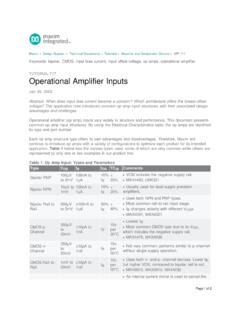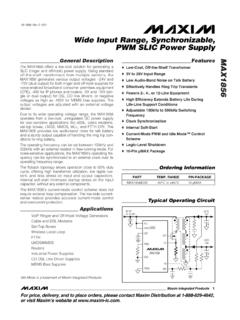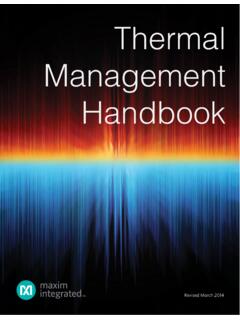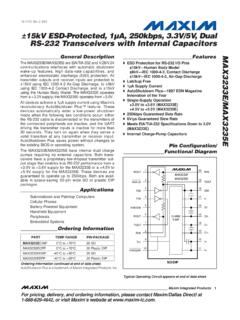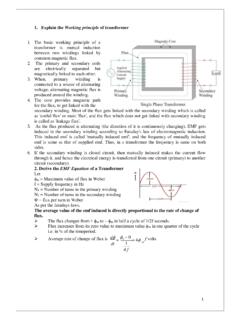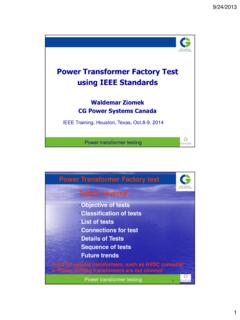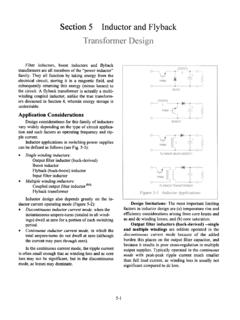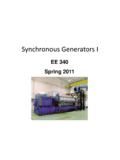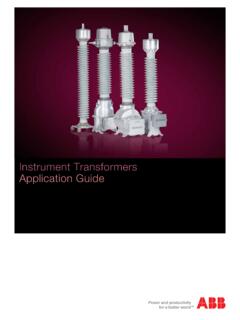Transcription of Snubber Circuits Suppress Voltage Transient Spikes in ...
1 Maxim > Design Support > Technical Documents > Tutorials > Circuit Protection > APP 848 Maxim > Design Support > Technical Documents > Tutorials > Power-Supply Circuits > APP 848 Keywords: multiple-output, flyback, dc-dc converters, power supply, isolated, primary-side, secondary-side, Voltage Snubber , Transient Voltage suppression, suppressor, suppresser multiple- winding ,transformer, MAX1856, telecom supply, power supplies TUTORIAL 848 Snubber Circuits Suppress Voltage TransientSpikes in Multiple Output DC-DC FlybackConverter Power SuppliesNov 12, 2001 Abstract: The flyback dc-dc converter topology results in significant cost and space savings for multipleoutput power supplies with high output Voltage for power levels up to 100W.
2 Flyback topologies storeand transfer energy using a transformer, which due to physical limitations can cause large voltagetransient Spikes during the switching cycle. This article outlines the design of dissipative voltagesuppression Circuits ( Voltage snubbers) that can be used to Suppress these transients on both theprimary and secondary side. The flyback topology (Figure 1A) results in significant cost and space savings for multiple output powersupplies with high output Voltage for power levels up to 100W. This topology uses a transformer, whichis essentially a coupled inductor with multiple windings on the same magnetic core.
3 Flyback topologiesoperate by storing energy in the transformer during the power switch on-time and transferring thisenergy to the output during the off-time. The energy is stored in a non-magnetic gap in series with thetransformer core. In practice, the multiple windings cannot all be equally well coupled to the corebecause of the physical separation between the windings. A small amount of energy is also stored withinand between these windings. This energy is represented in the circuit as a leakage inductance (Figure1B). Page 1 of 9 Figure 1A. Basic topology of flyback 1B. Equivalent transformer flyback topology is attractive for multiple output supplies because the output voltages track oneanother with line and load changes and because adding outputs to the system does not requireadditional ICs.
4 Despite its advantages, the flyback has the disadvantage of large Transient Voltage spikesat the drain of the power switch and at the secondary rectifier. These Spikes are a function of thePage 2 of 9leakage inductance in the flyback transformer. Snubbers control the effects of the leakage inductanceand improve the reliability of the power supply. Snubbers can be either passive or active networks. Passive Snubber network elements are restricted toresistors, capacitors, inductors and diodes. Passive snubbers can control either Voltage or current andmay be either dissipative or non-dissipative. If the energy in the Snubber is dissipated in a resistiveelement it is classified as a dissipative Snubber , but if the energy is returned to the input or movedahead to the output it is classified as non-dissipative.
5 This application note provides an overview of thedifferent types of passive dissipative Voltage snubbers used, guidelines on how they are designed, andtheir various limitations. In particular, snubbers used to reduce the stress on the switch and improveefficiency in a flyback topology are discussed. The first section enumerates the need for a Snubber on the primary side of a flyback converter. Thesecond section explains the need for a Snubber on the output side. This is followed by a discussion ofthe various types of dissipative Voltage Leakage Inductance and the MOSFET SwitchThe primary leakage inductance LLP in a flyback does not participate in the primary to secondary energytransfer and so has a negative impact on efficiency.
6 Since the leakage inductance does not find a pathfor the current built up in it during the switch on-time, it leads to a Voltage spike at the turn-off of theMOSFET and also delays the transfer of power from the primary to the secondary. The parasiticelements in the transformer and the switch determine the magnitude of this Voltage spike. At high outputvoltagesthe circuit parasitics become large relative to the amount of output power delivered. The primary leakage inductance, LLP, and the primary winding capacitance in the transformer, CP, andthe output capacitance, COSS, of the MOSFET form a parasitic LC network.
7 The peak Voltage is givenby:VPEAK = IP ( (LLP/(CP+COSS))) + VIN + VOUT/NWhere IP is the current level circulating at the time the MOSFET turns OFF, N is the ratio of secondaryto primary turns, VIN is the input Voltage , and VOUT is the output Voltage . The square root term in the above equation represents the characteristic impedance of the parasitic LCnetwork. Note that the highest Voltage Transient occurs when switching the highest level of current. Thisvoltage overshoot may cause excessive power dissipation in the MOSFET even if it is within safeoperating limits of the device and thus reduce the total efficiency.
8 Also, it may cause instability in theloop due to (dv/dt) induced spurious turn-on of the MOSFET as a result of the Transient Voltage Leakage Inductance and the Rectifier DiodeThe transformer secondary leakage inductance may couple with the reverse recovery current IREC of theoutput rectifier diode to cause ringing when the diode turns off. The transformer secondary leakageinductance LLS and the capacitance CD of the rectifier determine this resonant frequency. The ringingmay generate significant radiated and conducted noise. There is typically very little loss in the resonantcircuit so this network will cause many cycles of ringing after the spike.
9 The ringing can therefore affectthe current sense signal used by the controller in a flyback configuration. The overshoot caused by thisringing may exceed the diode Voltage rating and cause damage to the diode. The maximum positivevoltage across the rectifier can be estimated asVPEAK,S = IREC (LLS /CD) + VIN NPage 3 of 9 The damping of the resonant circuit should be optimized as excessive damping can also lead toincreased switching times and result in increased Snubber could therefore be used to clamp the Voltage spike or damp the ringing to reduce noise in thesystem or both. Depending on the function performed by the Snubber it can be broadly classified intothree categories:Rate-of-rise control Snubber Voltage clamp Snubber Damping snubberDamping snubbers are dissipative by definition.
10 Rate-of-rise control snubbers and Voltage clampsnubbers may be dissipative or non-dissipative. Non-dissipative snubbers are generally resonant typesnubbers. Snubbers can also be classified as polarized or non-polarized depending on whether energymoves in or out of the Snubber at either switching edge or at both. The polarized Snubber is not verygood at damping since it is not active during much of the cycle. It usually provides rate-of-rise control orclamping. Depending on whether the parameter being controlled is Voltage or current these snubbers canbe further classified as Voltage or current snubbers. Only dissipative type Voltage snubbers are discussedin this application Voltage SnubberThis Snubber is applicable to rate-of-rise Voltage control and/or clamping.
